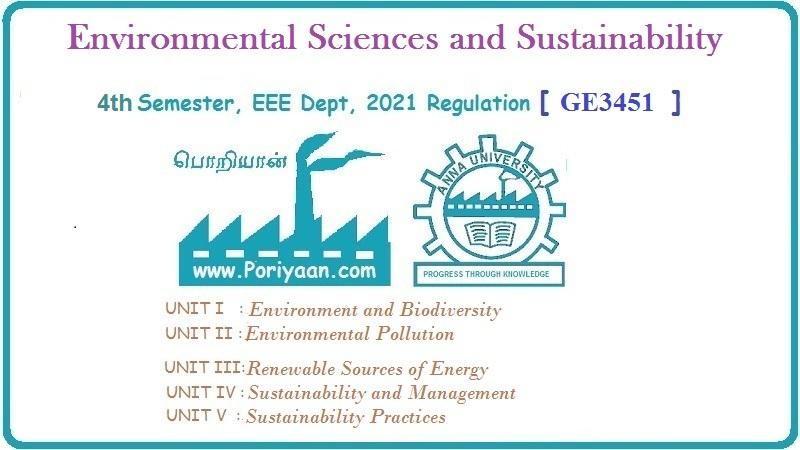Environmental Sciences and Sustainability: Unit V: Sustainability Practices
Carbon Sequestration
2 types | Sustainability Practices
Carbon dioxide is the most commonly produced greenhouse gas. Around 45 % of the CO2 emitted by humans remains in the atmosphere, which is a significant factor behind global warming.
Carbon Sequestration
•
Carbon dioxide is the most commonly produced greenhouse gas. Around 45 % of the
CO2 emitted by humans remains in the atmosphere, which is a
significant factor behind global warming.
•
Carbon sequestration is the process of capturing, securing and storing carbon
dioxide from the atmosphere.
•
Carbon dioxide (CO2) Capture and Storage (CCS) is the idea to
capture the CO2 from industrial processes like coal plants and then
store it in deep geological formations.
•
Carbon sequestration is one method of reducing the amount of carbon dioxide in
the atmosphere with the goal of reducing global climate change.
•
The idea is to stabilize carbon in solid and dissolved forms so that it doesn’t
cause the atmosphere to warm. The process shows tremendous promise for reducing
the human carbon footprint.
•
Carbon sequestration is key method for removing carbon from the earth’s
atmosphere.
•
There are two main types of carbon sequestration :
1.
Biological carbon sequestration and
2.
Geological carbon sequestration
1. Biological Sequestration
•
Biological carbon sequestration happens when carbon is stored in the natural
environment. This includes what are known as carbon sinks, such as forests,
grasslands, soil, oceans and other bodies of water. This is also known as an
indirect or passive form of sequestration.
1.
Forests
•
Forests and woodlands are considered one of the best forms of natural carbon
sequestration. CO2 binds to plants during photosynthesis, exchanging
it for oxygen as a purifying emission.
•
On average, forests store twice as much carbon as they emit, while an estimated
25 % of global carbon emissions are sequestered alongside forests in other
vegetative forms, such as grasslands or rangelands (fields, prairies, shrub
lands etc.).
•
Protecting such natural environments is therefore crucial to ensuring carbon
sinks capture CO2 effectively. Deforestation poses the biggest
threat to this natural process, as does construction or intensive agriculture.
2.
Soil
•
Through bogs, peat and swamps, carbon can be captured and stored as carbonates.
These carbonates build up over thousands of years as CO2 mixes with
other mineral elements, such as calcium or magnesium.
•
Eventually, carbon is released from the earth, but not for a very long time -
after more than 70,000 years in some cases.
3.
Oceans
•
Aquatic environments and large bodies of water are also great absorbers of CO2
They absorb another estimated 25 % of emitted CO2 from the
earth’s atmosphere. This carbon is mostly held in the upper layers of the
oceans.
•
Too much carbon can acidify the water, posing a threat to the biodiversity that
exists below - yet another reason to decarbonise our atmosphere.
2. Geological Carbon Sequestration
•
Geological carbon sequestration happens when carbon is stored in places such as
underground geological formations or rocks. This process is largely artificial
or direct, representing an effective way of neutralising emissions put into
human practices, such as manufacturing or construction.
•
It’s also largely technological as a result, with recent innovations showing
carbon being sequestered more effectively on larger scales. They include :
1.
Graphene production : The production of graphene requires CO2
as a raw material. Although limited to certain industries, it’s used heavily in
the production of the tech devices we use on a day-to-day basis, such smartphones
or computer processors.
2.
Engineered molecules : A fairly new science, scientists
can change the shape of molecules to form new compounds by capturing carbon
from the air. In practice, this could present an efficient way of creating raw
materials while reducing atmospheric carbon.
3.
Carbon Capture and Storage (CCS) : CCS involves capturing
carbon dioxide that’s been produced by power generation or industrial activity,
such as cement or steel-making. This CO-, is then compressed and transported to
deep underground facilities, where it’s injected into rock formations for
permanent storage.
Environmental Sciences and Sustainability: Unit V: Sustainability Practices : Tag: : 2 types | Sustainability Practices - Carbon Sequestration
Related Topics
Related Subjects
Environmental Sciences and Sustainability
GE3451 ESS 4th Semester | 2021 Regulation | 4th Semester EEE Dept 2021 Regulation
